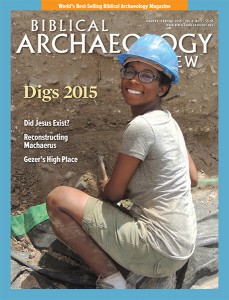
A. Bronze nail
B. Mason chisel
C. Brass pin
D. Copper awl
E. Sewing needle
Answer: (D) Copper awl
Dating to the late sixth or early fifth millennium B.C.E., this copper awl—a tool typically used for marking or piercing holes—is the oldest piece of metal ever recovered in the Middle East. Its discovery pushes back our understanding of metalworking in the Levant by several centuries.
Coming from the Chalcolithic site of Tel Tsaf in northern Israel near the Jordan River, the awl is cone-shaped and measures just 1.5 inches. In antiquity, the base of the metal awl would have been set in a wooden handle.
The awl was uncovered in 2007 from a sealed grave of a 40-year-old woman at Tel Tsaf in an excavation led by Professor Yosef Garfinkel of the Hebrew University; it is highlighted in a new study led by Dr. Danny Rosenberg of the University of Haifa.1 Although the researchers have identified the metal object as an awl, its purpose is unknown.
Before this discovery, it was thought that metalworking did not begin until the Late Chalcolithic period (second half of the fifth millennium). However, the site of Tel Tsaf has been radiometrically dated to the Middle Chalcolithic period, c. 5100–4600 B.C.E., and the undisturbed burial and the awl also date to this earlier period.
Already a library member? Log in here.
Institution user? Log in with your IP address.

